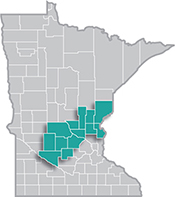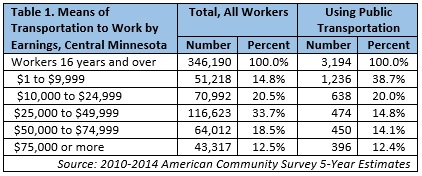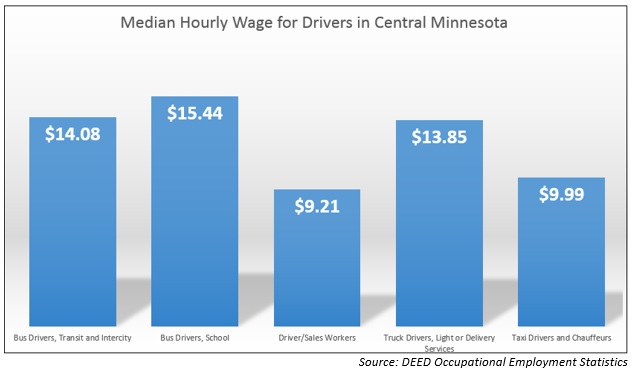 Central Minnesota is a manufacturing stronghold, with several global manufacturing firms operating there.
Central Minnesota is a manufacturing stronghold, with several global manufacturing firms operating there.
The region is especially well known for its expertise in food processing, printing, furniture manufacturing, appliances, machinery and heavy equipment manufacturing.
View our latest blogs on CareerForce. Want the freshest data delivered by email? Subscribe to our regional newsletters.
6/1/2016 2:29:28 PM
Luke Greiner
June 2016 - Moving people from home to work locations can be as simple as hopping into a car for a short drive to work; or as complicated as waking up early to get to a bus station, then changing routes multiple times before even arriving to work.
While most workers transport themselves to work privately, workers eager to use public transportation in many rural regions of the state and country often find themselves up a creek. Economy of scale and low population density work in conjunction to hamper the expansion of public and private transit networks and increase its cost in rural areas like much of Central Minnesota. Statewide, 3.5 percent of workers use public transit to get to work; while less than 1 percent of workers use public transit in Central Minnesota.
Although public transit is open for all workers to use, data from the American Community Survey show that the largest share of workers using public transportation in Central Minnesota have limited income. Roughly 40 percent of workers using Central Minnesota’s public transportation network to get to work earn less than $10,000 annually. The high share of workers with low incomes using public transportation in Central Minnesota makes sense since many of those riding buses to work are doing so out of necessity (Table 1).

Interestingly, data also shows that minority workers are over-represented in their use of public transit ridership for work compared to whites. Almost 6 percent of all workers in Central Minnesota are minority groups, yet 15 percent of workers using public transit identify as non-white.
Transit and intercity bus drivers operate many of the public and private buses in Central Minnesota. Although there are only 230 transit bus drivers in Central Minnesota, the function they perform is critical for many workers to maintain employment. In fact, the largest expense identified by DEED’s Cost of Living tool is transportation/car ownership, ranging from $725 to $1,164 per month for a typical Minnesota family in the 13 counties of Central Minnesota.
That cost is too high for many workers in the lowest income categories, which ironically could even include some bus drivers, as well as taxi drivers and chauffeurs. As shown in Figure 1, taxi drivers earned median wages below $10.00 per hour in 2016, as did driver/sales workers. Median wages were higher for bus drivers, both transit and school, ranging from $14.08 to $15.44 per hour in Central Minnesota, respectively. However, that means half of the bus drivers in the region were earning less than $15 per hour, which is close to the basic needs cost of living in Central Minnesota.

The competition for bus drivers is already fierce, and the qualifications required narrow the available labor pool even further. Jobs for bus drivers are projected to increase by 14.7 percent in the next decade according to DEED’s Employment Projections, much faster than the growth of all occupations in the region. The increase in transit and intercity bus drivers is being pushed higher by an aging and increasingly diverse population that will continue to rely on passenger transportation as driving themselves becomes more problematic.
Demographic data of public transportation taken from the U.S. Census Bureau, 2010-2014 American Community Survey 5-Year Estimates, Table S0802. Means of Transportation to Work by Selected Characteristics.
Contact Luke Greiner at 320-308-5378.